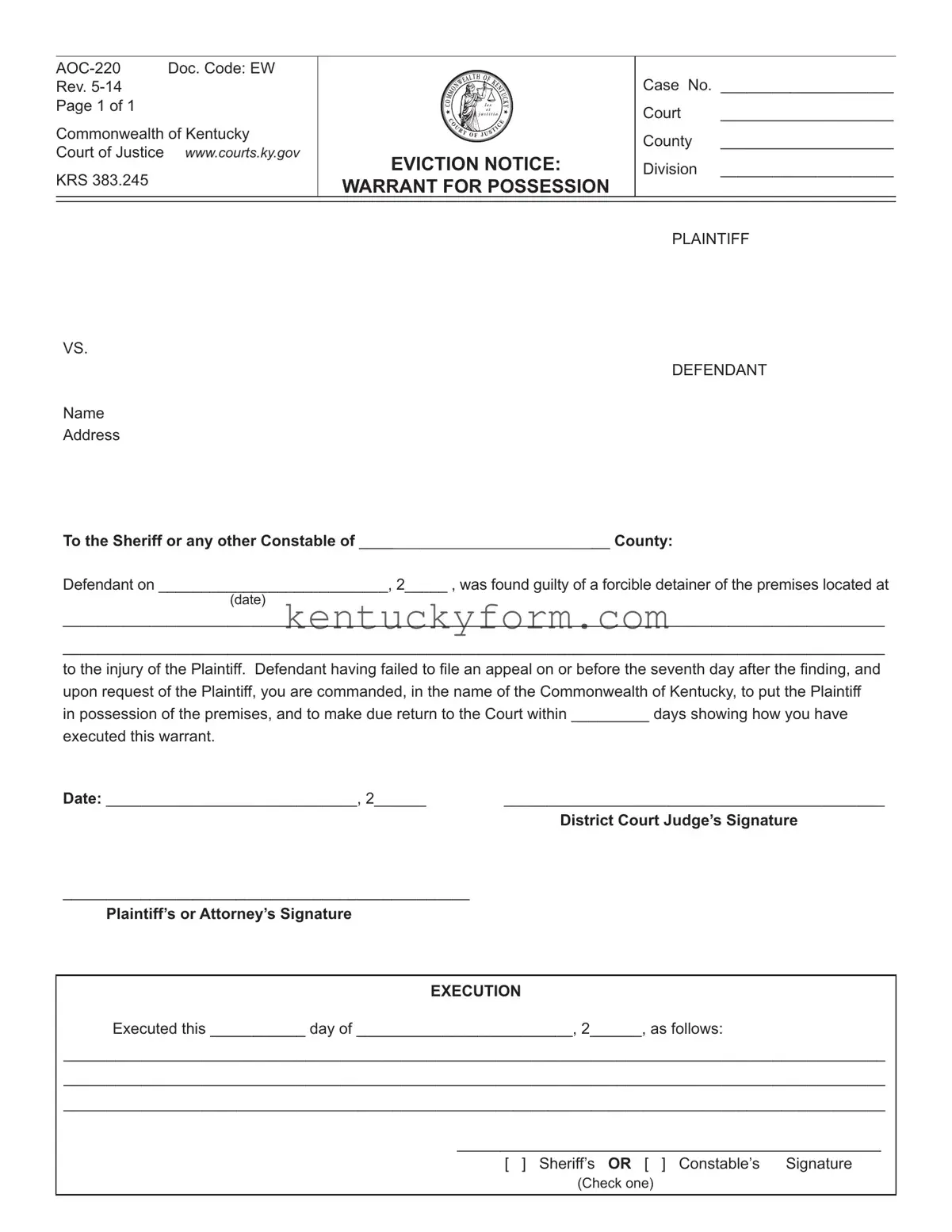AOC-220 |
Doc. Code: EW |
|
|
|
|
|
LT H |
OF |
|
|
|
|
|
|
|
|
|
|
|
|
|
|
|
Rev. 5-14 |
|
|
|
|
EA |
K |
|
Case No. ____________________ |
|
|
|
|
W |
|
|
|
|
|
|
|
|
|
E |
|
|
|
|
O |
N |
|
|
|
N |
|
|
M |
|
|
|
|
T |
|
M |
|
|
|
|
|
|
U |
|
|
|
|
|
|
|
|
|
|
|
C |
|
|
|
|
|
|
|
|
|
|
|
|
|
|
Page 1 of 1 |
|
O |
|
|
|
|
|
l e x |
K |
|
|
|
C |
|
|
|
|
|
Y |
Court |
____________________ |
|
|
|
|
|
|
|
e t |
|
|
|
|
|
|
|
|
|
j u s t i t i a |
|
|
|
C |
|
|
|
|
|
E |
|
|
O |
|
|
|
IC |
|
|
Commonwealth of Kentucky |
|
|
U |
|
|
|
|
|
|
|
|
|
R |
T |
|
|
T |
|
|
|
|
|
|
|
|
O F |
JU |
|
|
County |
____________________ |
|
|
|
|
|
|
|
|
|
Court of Justice |
www.courts.ky.gov |
|
|
|
|
|
|
|
|
|
EVICTION NOTICE: |
|
|
KRS 383.245 |
|
Division |
____________________ |
|
WARRANT FOR POSSESSION |
|
|
|
|
|
|
|
|
|
|
|
|
|
|
|
|
|
PLAINTIFF |
VS.
DEFENDANT
Name
Address
To the Sheriff or any other Constable of _____________________________ County:
Defendant on ___________________________, 2_____ , was found guilty of a forcible detainer of the premises located at
(date)
_______________________________________________________________________________________________
_______________________________________________________________________________________________
to the injury of the Plaintiff. Defendant having failed to ile an appeal on or before the seventh day after the inding, and upon request of the Plaintiff, you are commanded, in the name of the Commonwealth of Kentucky, to put the Plaintiff in possession of the premises, and to make due return to the Court within _________ days showing how you have
executed this warrant.
Date: _____________________________, 2______ |
____________________________________________ |
|
District Court Judge’s Signature |
_______________________________________________ |
|
Plaintiff’s or Attorney’s Signature |
|
EXECUTION
Executed this ___________ day of _________________________, 2______, as follows:
_______________________________________________________________________________________________
_______________________________________________________________________________________________
_______________________________________________________________________________________________
_________________________________________________
[ ] Sheriff’s OR [ ] Constable’s Signature (Check one)

